Learn the basics about concrete mixtures and get an overview of concrete construction procedures.
Bugholes
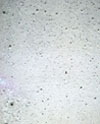 One of the primary influences affecting the surface aesthetics of concrete are bugholes. Bugholes, pinholes, blowholes, surface voids – they are recognized by various names, but all refer to a common problem that contractors want to minimize. Bugholes, are small, regular or irregular cavities (usually not exceeding 9/16 inch) resulting from entrapment of air bubbles on the surface of vertically formed concrete structures during placement and consolidation. Read more on bugholes.
One of the primary influences affecting the surface aesthetics of concrete are bugholes. Bugholes, pinholes, blowholes, surface voids – they are recognized by various names, but all refer to a common problem that contractors want to minimize. Bugholes, are small, regular or irregular cavities (usually not exceeding 9/16 inch) resulting from entrapment of air bubbles on the surface of vertically formed concrete structures during placement and consolidation. Read more on bugholes.
Building Tips for Trouble-Free Concrete Slabs
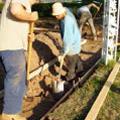 Concrete is the material of choice for driveways, sidewalks, patios, steps, and for garages, basements, and industrial floors. It is relatively inexpensive to install and provides an attractive, durable surface that is easy to maintain. Proper attention to the standard practices and procedures for constructing exterior or interior concrete can yield a concrete surface that will provide long-lasting, superior performance. Learn more building tips that will aid in the construction of quality concrete projects.
Concrete is the material of choice for driveways, sidewalks, patios, steps, and for garages, basements, and industrial floors. It is relatively inexpensive to install and provides an attractive, durable surface that is easy to maintain. Proper attention to the standard practices and procedures for constructing exterior or interior concrete can yield a concrete surface that will provide long-lasting, superior performance. Learn more building tips that will aid in the construction of quality concrete projects.
Cold Weather Concreting
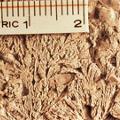 Cold weather concreting is a common and necessary practice, and every cold weather application must be considered carefully to accommodate its unique requirements. The current American Concrete Institute definition of cold-weather concreting, as stated in ACI 306 is, “when the air temperature has fallen to, or expected to fall below 40 degrees Fahrenheit during the protection period.” This definition can potentially lead to problems with concrete freezing at an early age.
Cold weather concreting is a common and necessary practice, and every cold weather application must be considered carefully to accommodate its unique requirements. The current American Concrete Institute definition of cold-weather concreting, as stated in ACI 306 is, “when the air temperature has fallen to, or expected to fall below 40 degrees Fahrenheit during the protection period.” This definition can potentially lead to problems with concrete freezing at an early age.
Rule number one is that all concrete must be protected from freezing until it has reached a minimum compressive strength of 500 psi, which typically happens within the first 24 hours. In addition, whenever air temperature at the time of concrete placement is below 40 degrees Fahrenheit and freezing temperatures within the first 24 hours after placement are expected, the following general issues should be considered: (1) initial concrete temperature as delivered; (2) protection while the concrete is placed, consolidated, and finished, and (3) curing temperatures to produce quality concrete.
View more on
cold weather concreting..
Conductive Concrete
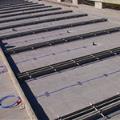 Concrete does a very good job of reflecting solar energy. Solar reflectance of the portland cement itself has the greatest effect on concrete reflectance: the higher the cement reflectance, the higher the concrete reflectance. Read more on conductive concrete.
Concrete does a very good job of reflecting solar energy. Solar reflectance of the portland cement itself has the greatest effect on concrete reflectance: the higher the cement reflectance, the higher the concrete reflectance. Read more on conductive concrete.
Curing in Construction
 Curing is the process in which the concrete is protected from loss of moisture and kept within a reasonable temperature range. This permits the chemical reactions between cement and water to take place. The result of this process is increased strength and decreased permeability, both of which improve durability in well proportioned concrete. Curing is also a key player in mitigating cracks in the concrete, which can also severely impact durability. The terms curing and drying are sometimes incorrectly used interchangeably.
Curing is the process in which the concrete is protected from loss of moisture and kept within a reasonable temperature range. This permits the chemical reactions between cement and water to take place. The result of this process is increased strength and decreased permeability, both of which improve durability in well proportioned concrete. Curing is also a key player in mitigating cracks in the concrete, which can also severely impact durability. The terms curing and drying are sometimes incorrectly used interchangeably.
The term “concrete moisture” is understood to mean the total water used in the concrete batch, plus curing water, minus the water bound in hardened cement due to hydration. Drying begins when water is no longer available at the exposed surface.
In addition to curing being a fundamental step in the concreting process, the drive for sustainability makes paying particular attention to curing all that more important. When smart, suitable, and practical curing is used, the amount of cement required to achieve a given strength and durability can be reduced or partially reduced. It can be partially replaced with by supplementary cementitious materials. This often leads to a reduction in the cost as well as the carbon footprint of the concrete mixture.
It is also necessary that the concrete be allowed to properly mature to provide the full service life. It is this service life, which can extend to hundreds or thousands of years, that provides concrete with the inherent ability to span the needs of many generations. Read more on curing concrete.
Contraction/Control Joints in Concrete Flatwork
 The most widely used method to control random cracking in concrete slabs is to place contraction/control joints in the concrete surface. As concrete hardens, there is a reduction in volume (shrinkage), often resulting in cracking of concrete. Joints produce an aesthetically pleasing appearance since the crack takes place in a controlled manner below the finished concrete surface. The concrete has still cracked, which is normal behavior, but the absence of random cracks at the concrete surface gives the appearance of an un-cracked section.
The most widely used method to control random cracking in concrete slabs is to place contraction/control joints in the concrete surface. As concrete hardens, there is a reduction in volume (shrinkage), often resulting in cracking of concrete. Joints produce an aesthetically pleasing appearance since the crack takes place in a controlled manner below the finished concrete surface. The concrete has still cracked, which is normal behavior, but the absence of random cracks at the concrete surface gives the appearance of an un-cracked section.
Contraction joints should be placed to produce panels that are as square as possible and never exceeding a length to width ratio of 1.5 to 1. Joints are commonly spaced at distances equal to 24 to 30 times the slab thickness and established to a depth of one quarter of the slab thickness. Joints should be sawed as soon as the concrete will withstand the energy of sawing without raveling or dislodging aggregate particles. For most concrete mixtures, this means sawing should be completed within the first six to 18 hours and never delay more than 24 hours. View more on contraction joints.
Drying of Concrete
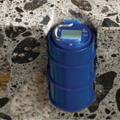 Unwanted moisture in concrete floors routinely causes millions of dollars in damage to buildings in the United States. Problems from excessive moisture include deterioration and de-bonding of floor coverings, trip-and-fall hazards, microbial growth leading to reduced indoor air quality, staining, and deterioration of building finishes.
Unwanted moisture in concrete floors routinely causes millions of dollars in damage to buildings in the United States. Problems from excessive moisture include deterioration and de-bonding of floor coverings, trip-and-fall hazards, microbial growth leading to reduced indoor air quality, staining, and deterioration of building finishes.
The terms curing and drying are frequently used interchangeably with regard to the moisture condition of new concrete slabs.
The term “concrete moisture” is understood to mean the total water used in the concrete batch, plus curing water, minus the water bound in hardened cement due to hydration. Drying begins when water is no longer available at the exposed surface. Read more about the drying of concrete.
Engineered Cementitious Composite Link Slabs
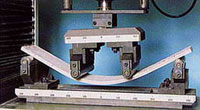 Engineered cementitious composite has been shown to limit cracking as well as exhibit high ductility. This ductility has led it to be called “bendable concrete”. Engineered cementitious composite is a proprietary mix design using cement, sand, fly ash, water, admixtures, and fibers. Its most distinctive mechanical property is an ultimate tensile strain capacity of three to five percent. This strain capacity, more than 300 times that of normal concrete, is realized through the formation of a large number of microcracks as the load increases and allows the material to deform similar to ductile metals.
Engineered cementitious composite has been shown to limit cracking as well as exhibit high ductility. This ductility has led it to be called “bendable concrete”. Engineered cementitious composite is a proprietary mix design using cement, sand, fly ash, water, admixtures, and fibers. Its most distinctive mechanical property is an ultimate tensile strain capacity of three to five percent. This strain capacity, more than 300 times that of normal concrete, is realized through the formation of a large number of microcracks as the load increases and allows the material to deform similar to ductile metals.
Finishing Air-Entrained Concrete
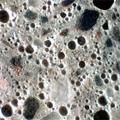 Used in many applications, air-entrained concrete is concrete that uses air-entraining cement or an air-entraining admixture to produce a system of very fine air bubbles (usually much less than 1 millimeter in diameter) within the hardened cement paste. These bubbles develop during the mixing process and are stabilized through action by the air-entraining agent. The primary use of air-entraining concrete is for freeze/thaw resistance. The air voids provide pressure relief sites during a freezing event, allowing the water inside the concrete to freeze without inducing large internal stresses.
Used in many applications, air-entrained concrete is concrete that uses air-entraining cement or an air-entraining admixture to produce a system of very fine air bubbles (usually much less than 1 millimeter in diameter) within the hardened cement paste. These bubbles develop during the mixing process and are stabilized through action by the air-entraining agent. The primary use of air-entraining concrete is for freeze/thaw resistance. The air voids provide pressure relief sites during a freezing event, allowing the water inside the concrete to freeze without inducing large internal stresses.
Hard troweling is a process by which a finisher uses a steel trowel to densify the surface of the concrete. This finish is optional and produces a hard, smooth surface. Hard troweling is not recommended for air-entrained concrete for several reasons. Read more on finishing air-entrained concrete.
Hot Weather Concreting
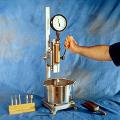 When the temperature of freshly mixed concrete approaches approximately 77 degrees Fahrenheit adverse site conditions can adversely impact the quality of concrete. Ambient temperatures above 90 degrees Fahrenheit and the lack of a protected environment for concrete placement and finishing (enclosed building) can contribute to difficulty in producing quality concrete.
When the temperature of freshly mixed concrete approaches approximately 77 degrees Fahrenheit adverse site conditions can adversely impact the quality of concrete. Ambient temperatures above 90 degrees Fahrenheit and the lack of a protected environment for concrete placement and finishing (enclosed building) can contribute to difficulty in producing quality concrete.
The precautions required to ensure a quality end product will vary depending on the actual conditions during concrete placement and the specific application for which the concrete will be used. In general, if the temperature at the time of concrete placement will exceed 77 degrees Fahrenheit, a plan should be developed to negate the effects of high temperatures. Read more on the suggested precautions for hot weather concreting.
Safety Measures for Concrete Construction
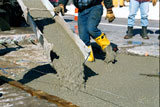 Like any construction sector, safety is of top importance in concrete construction. Although claiming one of the lower jobsite-injury rates, dangers exist with both the material aspects and construction practices of concrete construction and must be addressed to ensure a safe worksite. Heightened awareness, improved safety training programs, and diligent enforcement are the keys to improving safety on the jobsite. Read more on safety measures for concrete construction.
Like any construction sector, safety is of top importance in concrete construction. Although claiming one of the lower jobsite-injury rates, dangers exist with both the material aspects and construction practices of concrete construction and must be addressed to ensure a safe worksite. Heightened awareness, improved safety training programs, and diligent enforcement are the keys to improving safety on the jobsite. Read more on safety measures for concrete construction.
Vapor Retarders Protect Floor Finishes over Slabs
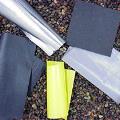 Vapor retarders are sheet materials used under concrete slabs on ground to restrict the flow of moisture vapor from the subgrade into and through the slab. Moisture migration through concrete slabs can lead to microbial growths and failures of adhesives, flooring coverings, and coatings. Therefore, all concrete slab-on-ground floors that will receive floor coverings or coatings must have a vapor retarder below the slab. Vapor retarders are produced to meet specifications such as ASTM E1745, Standard Specification for Water Vapor Retarders Used in Contact with Soil or Granular Fill Under Concrete Slabs, or ASTM D4397, Standard Specification for Polyethylene Sheeting for Construction, Industrial, and Agricultural Applications.
Vapor retarders are sheet materials used under concrete slabs on ground to restrict the flow of moisture vapor from the subgrade into and through the slab. Moisture migration through concrete slabs can lead to microbial growths and failures of adhesives, flooring coverings, and coatings. Therefore, all concrete slab-on-ground floors that will receive floor coverings or coatings must have a vapor retarder below the slab. Vapor retarders are produced to meet specifications such as ASTM E1745, Standard Specification for Water Vapor Retarders Used in Contact with Soil or Granular Fill Under Concrete Slabs, or ASTM D4397, Standard Specification for Polyethylene Sheeting for Construction, Industrial, and Agricultural Applications.
Construction practice and placement of vapor retarders has been the subject of much debate for many years. Some practitioners believe that concrete placed directly on a vapor retarder will bleed excessively, warp and crack more frequently, and take longer to dry than a slab placed on a compacted granular subbase. Others believe that vapor retarders function best to exclude moisture when directly below the concrete with no intervening material that can act as plenum space for the passage of moisture. ACI Committee 302 recommends that any floor that will receive a moisture-sensitive finish should have a vapor retarder directly under the concrete slab with no intervening blotter or cushion layer. Read more on vapor retarders.